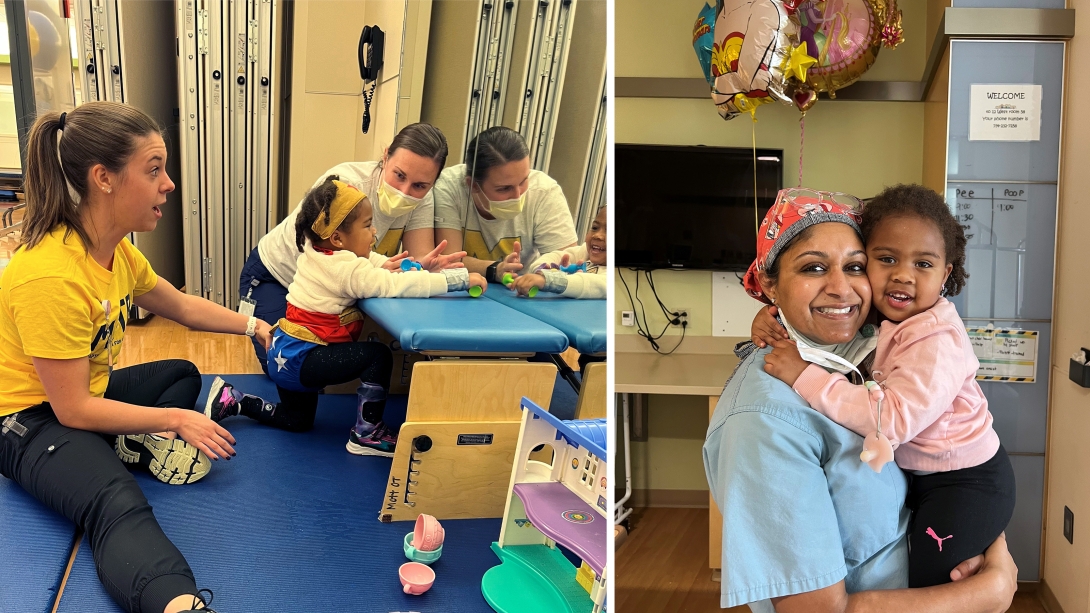University of Michigan Health C.S. Mott Children’s Hospital among few programs in the country that offers technique
5:00 AM
Author |

Call her Wonder Woman.
Three-year-old Simone Elwart has taken on the persona of her favorite superhero and continues to grow stronger each day as she rehabs from a customized spinal procedure that she received last year at University of Michigan Health C.S. Mott Children’s Hospital.
Simone was diagnosed with cerebral palsy and spastic diplegia, greatly affecting her ability to walk, before her second birthday.
In June 2023, her mother, Joy Elwart, learned that Simone would be a good candidate for a minimally invasive selective dorsal rhizotomy, a complex spinal nerve root surgery that involves eliminating excessive reflexes and has been shown to result in a decrease in muscle spasticity.
She scheduled an appointment with Mott pediatric neurosurgeon Neena Marupudi, M.D., M.S. right away.
“I was super nervous about it,” Elwart said. “Obviously, it’s a spinal surgery and my little girl wasn’t even three at the time. It was just overwhelming. Then I met Dr. Marupudi, and I think pretty much all of my fears just went out the window.”
Ability to move
Cerebral palsy refers to a group of chronic neurological disorders affecting the ability to move, caused by injury or other changes in the developing fetal or infant brain, Marupudi says. In Simone’s case, she has spastic diplegia, meaning she has abnormal tone and spasticity affecting her legs, and therefore her ability to walk independently.
The original procedure, Marupudi says, involves surgeons removing segments of the spine to see the nerve roots.
But the procedure that she performed on Simone was much less invasive, requiring only about a three centimeter incision on the back to gain access to the nerve roots. Once she gained access, she was able to stimulate the nerve roots to see which muscle groups they were going to and make little snips in the sensory nerve rootlets to reduce the tone. Mott is one of the few programs in the country that offers this technique and customizes it to each child.
At Mott, on the main floor, they have a full-size Wonder Woman statue, and she just thought it was the best thing ever and we went and saw it every single day. She would say ‘Mom, don’t call me Simone, I’m Wonder Woman.’ "
--Joy Elwart, patient’s mother
When Simone came out of surgery, everything had gone according to plan and her small incision was covered by gauze cut into the shape of a “W” with the name “Wonder Woman” written on it. This personalized artwork was done by another doctor on Simone’s team, Katherine Holste, M.D.
Tailored to each child
Marupudi says gestures like those go a long way for patients, caregivers and doctors alike and also highlight the individualized care that goes into these procedures.
“This is a procedure that is tailored to each child,” Marupudi said. “It’s not a standard procedure. We evaluate the child, and we do a lot of testing. Simone went through endurance testing. We watched her walk up and down hallways. We did video testing. We evaluated each of her muscle groups and documented all of this and came up with a strategic plan.”

Just a few days after the surgery, Simone was sitting up and ready to start rehabbing, a timeframe her mother just couldn’t believe was real. Simone was even able to quickly learn to do things she hadn’t been able to do previously, such as sitting “crisscross applesauce.” She made these strides during her inpatient rehab sessions dressed, of course, as Wonder Woman.
“At Mott, on the main floor, they have a full-size Wonder Woman statue, and she just thought it was the best thing ever and we went and saw it every single day,” Elwart said. “She would say ‘Mom, don’t call me Simone, I’m Wonder Woman.’ We love the Wonder Woman aspect of it, but she really is like a little Wonder Woman. She is such a tough little kid.”
Superhero strengths
Marupudi initially connected with Simone because of her own love of Wonder Woman. She says her office is full of paraphernalia related to the iconic female superhero. She even has a Wonder Woman-themed scrub cap that she wore while performing Simone’s surgery.
“These superheroes that kids believe in, there is an uplifting message behind them, and I think this is fun, but also important because it inspires health professionals to be better team members for the people around us and for our patients,” Marupudi said.
Since receiving the surgery, Simone has continued to work with her physical therapy team and is on track with her progress. She especially loves the social aspect of her physical therapy meetings, making sure to say hello and chat with not only her own physical therapist, but everyone else who happens to be working that day as well.
She also bonded with the doctors, nurses and other medical staff that were on her team and still will sometimes ask her mom if she “can go back to her hospital to see her friends.”
Sign up for Health Lab newsletters today. Get medical tips from top experts and learn about new scientific discoveries every week by subscribing to Health Lab’s two newsletters, Health & Wellness and Research & Innovation.
Sign up for the Health Lab Podcast: Add us on Spotify, Apple Podcasts or wherever you get you listen to your favorite shows.

Explore a variety of health care news & stories by visiting the Health Lab home page for more articles.

Department of Communication at Michigan Medicine
Want top health & research news weekly? Sign up for Health Lab’s newsletters today!





